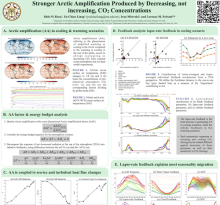Stronger Arctic Amplification Produced by Decreasing, not increasing, CO2 Concentrations
Yu-Chiao
Liang
National Taiwan University
Poster
Arctic amplification (AA), the amplified warming in the Arctic compared to the rest of the globe, is generally attributed to the increasing concentrations of carbon dioxide (CO2) in the atmosphere, and has been widely studied. In contrast, little attention has been paid to AA under decreasing levels of CO2, when the Arctic region experiences a greater temperature decrease than the rest of the planet. Using climate model experiments forced with a wide range of CO2 concentrations, we show that AA indeed occurs as a consequence of decreasing CO2 concentrations, and that it is stronger than the AA under increasing CO2 concentrations. Feedback analysis reveals that the Planck, lapse-rate, and albedo feedbacks are the main contributors to producing AAs forced by CO2 increase and decrease, but the stronger lapse-rate feedbacks associated with decreasing CO2 level give rise to stronger AA in the cooling case. We further find that the increasing CO2 concentrations shift the peak month of AA from November to December or January, depending on the forcing strength. In contrast, decreasing CO2 levels are unable shift the peak of AA earlier than October, bounded by the maximum sea-ice increase in September that is independent of forcing strength. Such seasonality changes are also found in the lapse-rate feedbacks, but do not appear in other feedbacks nor in atmospheric and oceanic heat transport processes. Our results highlight the asymmetric responses of AA, as evidenced by the disproportional variations in its intensity and seasonality, to the increasing and decreasing CO2 concentrations. These findings have significant implications for understanding how carbon removal could impact the Arctic climate, ecosystems, and socio-economic activities.

liang-yuchiao-polar-poster.pdf
(10.07 MB)
